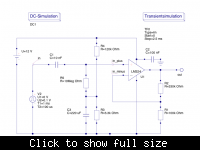Tom-nor
Newbie level 6
Hey guys!
Would be awsome if anyone pls could take a quick look at my problem.
Got a +- 300 mV input singal comming from a piezo electric sensor.
My ADC works in the range 0-2.8 V.
So iam gna bias the input signal with 1 volt. I need to take advantage of the opamps high input impedance, so i have conected the inputsignal trough a capacitor and to the opamps + input.
But iam having slight problems with how to connect the voltage divider to bias the signal, without messing up the amplifying ( which i want to be 1) or the input impedance.
I got a single 12 volt power suply.
Thnx for your time, i hope the info i have given you is enough and i apologize for my english.
Regards: Tom
Would be awsome if anyone pls could take a quick look at my problem.
Got a +- 300 mV input singal comming from a piezo electric sensor.
My ADC works in the range 0-2.8 V.
So iam gna bias the input signal with 1 volt. I need to take advantage of the opamps high input impedance, so i have conected the inputsignal trough a capacitor and to the opamps + input.
But iam having slight problems with how to connect the voltage divider to bias the signal, without messing up the amplifying ( which i want to be 1) or the input impedance.
I got a single 12 volt power suply.
Thnx for your time, i hope the info i have given you is enough and i apologize for my english.
Regards: Tom
